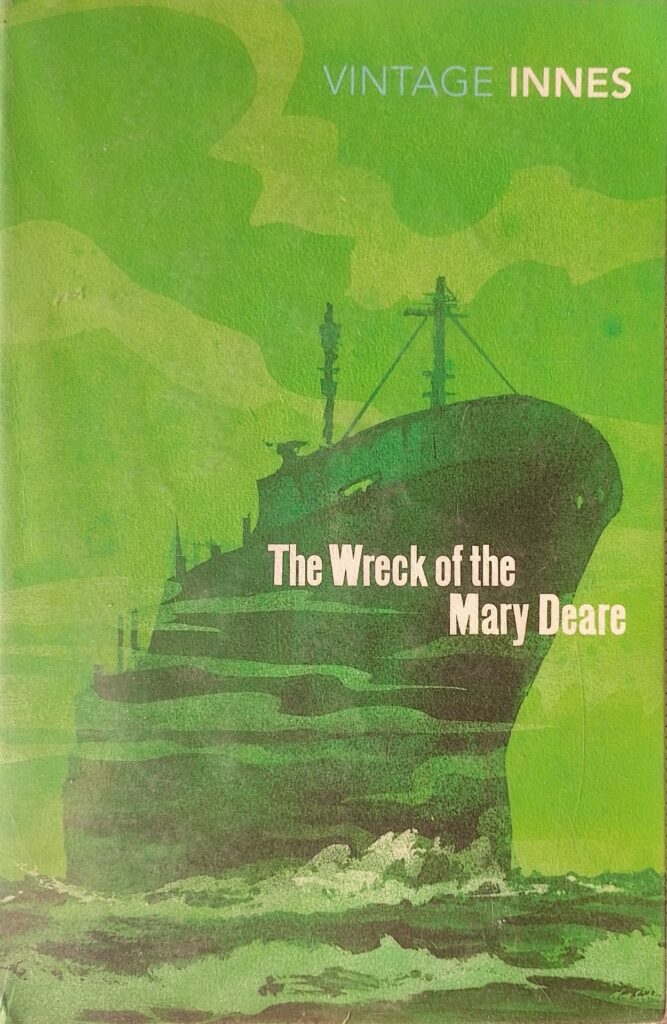First published 1956. Vintage paperback, 2013, pp272, c.85,000 words.
This is a cracking thriller, and right in the mainstream of Innes’ work. As the title suggests, it’s a thriller focused on the sea, and few are as good as Innes in describing all its moods.
Innes makes few concessions to those unfamiliar with boat jargon. It may not be vital to know what a ‘binnacle’ is [p3], but using such terms without explanation adds tremendous colour and aids the feeling of authenticity – as long as understanding a particular term is not crucial to following the plot. Innes is not heavy handed with his expertise, mostly working the ship components into the story as part of settings and actions. Only when he comes to describing the fearsome waters around the Channel Islands does he slip briefly into ‘tell’ mode [p221]. Clearly Innes has sailed these waters and seen the seaman’s hell that are The Minkies, an area of sea, around twenty-four square miles in extent, strewn with jagged rocks that are mostly covered at high-tide. The tidal range is vast there, up to ten metres, and the currents consequently very strong.
One of the disadvantages in being so true to the real is when the plot calls for something unrealistic, leaving those with boating experience to raise an eyebrow. Here, two very different vessels, one a sailing yacht, one a motor boat, leave Lulworth Cove on the south coast at the same time, in the evening, after it has got dark. By dawn the next morning, having crossed the English Channel, they are still within close range of each other. Even a fractional difference in speed would have separated the two by a great deal, particularly given the strong tides and inconstant wind over that passage [p222]. Plausibility has been let go in favour of plot. Rather similarly, a small, leaky, wooden dinghy with two men aboard would behave quite differently to a larger, metal dinghy rowed by one man. The large dinghy ‘riding higher and easier’ would be much lighter and much more susceptible to the wind [p239].
The protagonist in John Sands who with a couple of friends is setting up a ship salvage business. He comes across as a competent seaman and man of action but not a great leader. He fails to take sides when Gideon Patch, a man he and his colleague are supposedly helping, insists on a dangerous course which his friend forcefully argues against [p223]. He also fails to pursue ‘the girl’, after a brief overture [p84], giving her up to the stronger-willed Patch.
There is a cracking court-room scene occupying the central section of the book where the causes of the loss of the Mary Deare are being investigated. In the hands of a good writer, court-rooms provide a fine crucible for high drama, as here.
There are a few period touches, of course: everyone smokes and drinks spirits, and women are largely absent from the action. At one point, someone says “thank you, gentlemen for your attendance.” when there are clearly women present [p188].
The first two thirds of this are absolutely excellent: plausible, exciting and well written. The last part seems a bit over-cooked, although it is jolly thrilling. Innes is on top form here with his descriptions of the sea, that merciless and cruel true master of destiny.
Wikipedia biography of Innes: https://en.wikipedia.org/wiki/Hammond_Innes
Wikipedia summary of the book: https://en.wikipedia.org/wiki/The_Wreck_of_the_Mary_Deare
Others’ reviews of the book: https://www.goodreads.com/book/show/1247535.The_Wreck_Of_The_Mary_Deare?ref=nav_sb_ss_1_21
© William John Graham, June 2024

